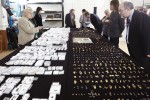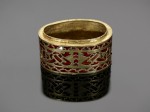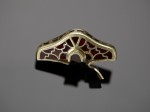 In the five years since the discovery of the Staffordshire Hoard, the more than 4,000 pieces of the hoard have been cleaned, cataloged and grouped by physical and stylistic similarities. Five hundred more objects and fragments were found hidden in the soil clumped on the pieces and in a follow-up 2012 excavation. About 1,000 new joins have been discovered, allowing conservators to puzzle together objects that have never been seen before, including previously unknown types of sword fittings and mounts. More than 1,500 pieces have been identified as fragments of a single helmet. The hoard has also been officially dated to the late 6th, early 7th century, an important transitional period between the decline of traditional Anglo-Saxon polytheism and the advent of Christianity.
In the five years since the discovery of the Staffordshire Hoard, the more than 4,000 pieces of the hoard have been cleaned, cataloged and grouped by physical and stylistic similarities. Five hundred more objects and fragments were found hidden in the soil clumped on the pieces and in a follow-up 2012 excavation. About 1,000 new joins have been discovered, allowing conservators to puzzle together objects that have never been seen before, including previously unknown types of sword fittings and mounts. More than 1,500 pieces have been identified as fragments of a single helmet. The hoard has also been officially dated to the late 6th, early 7th century, an important transitional period between the decline of traditional Anglo-Saxon polytheism and the advent of Christianity.
 Researchers have now turned to analysis of the composition of the alloys. Minute scrapings taken from the surface of about 200 gold objects were viewed through a scanning electron microscope exposing an ingenious system of making gold with a high silver content look as shiny as pure as the real thing.
Researchers have now turned to analysis of the composition of the alloys. Minute scrapings taken from the surface of about 200 gold objects were viewed through a scanning electron microscope exposing an ingenious system of making gold with a high silver content look as shiny as pure as the real thing.
The technique was not written down in Anglo-Saxon times, and had never been detected in metalwork from the period, but a similar technique was known from Roman accounts. It must have been spoken about by the brilliant Anglo-Saxon metal workers, and involved taking gold which was alloyed with up to 25% silver, and heating it in an acid solution – made from iron rich minerals such as brick dust – so that at the surface the silver leached out and could be burnished off. The surface would then appear to be the highest quality gold, but just below the surface there was inferior metal.
“They knew what they were doing,” said Eleanor Blakelock, the scientist who discovered their secret. “This wasn’t something which could possibly have happened by accident.”
 The technique left the surface with more than 90% gold while just underneath it was 70 to 75% gold. The shiny surfaces could be enhanced with contrasting decoration like wire filigree made from darker, less pure gold. The objects intended for males — belt buckles, weapon fittings — appear to have a higher gold content than jewelry worn by women. Experts don’t believe it was done as a deception to pass off a cheaper alloy as gold. It was just a way to make the best of the materials at hand.
The technique left the surface with more than 90% gold while just underneath it was 70 to 75% gold. The shiny surfaces could be enhanced with contrasting decoration like wire filigree made from darker, less pure gold. The objects intended for males — belt buckles, weapon fittings — appear to have a higher gold content than jewelry worn by women. Experts don’t believe it was done as a deception to pass off a cheaper alloy as gold. It was just a way to make the best of the materials at hand.
 The discovery has also revealed new information about some of the objects. The five hilt fittings from a seax, a single-edged knife, for example, have an odd man out. Four of the pieces have similar alloy composition and were given the acid solution surface treatment. The fifth piece, the pommel cap, has a different alloy composition and was not given any surface treatment. That suggests it was a replacement piece or a later addition to the seax.
The discovery has also revealed new information about some of the objects. The five hilt fittings from a seax, a single-edged knife, for example, have an odd man out. Four of the pieces have similar alloy composition and were given the acid solution surface treatment. The fifth piece, the pommel cap, has a different alloy composition and was not given any surface treatment. That suggests it was a replacement piece or a later addition to the seax.
Other analytical methods archaeologists used to test the metal content of the surface are not able to detect this technique, which means 1,400 year-old Anglo-Saxon metalworkers have done an impressive number on 21st century technology. Archaeologists now know they can’t trust standard surface analysis to determine the gold content of an artifact, Anglo-Saxon or otherwise.
In related news, the Birmingham Museum & Art Gallery, co-owner of the hoard along with the Potteries Museum & Art Gallery, opened its new permanent Staffordshire Hoard Gallery on Friday. About 300 pieces are on display in an exhibition that covers how the objects were made, how they were used before being broken up and buried, the tools conservators employed to clean the hoard. There’s even a Mead Hall to give visitors a glimpse into the life of the kind of Anglo-Saxon lord who would have owned such expensive weapons.
History West Midlands has a wonderful collection of videos uploaded this year about the conservation of the Staffordshire Hoard and overviews of eight featured artifacts (subscribe to the YouTube channel for future videos) I dare you to watch just one.
[youtube=http://youtu.be/CcriG8UIRVI&w=430]
[youtube=http://youtu.be/m4jUvT3hG-A&w=430]
[youtube=http://youtu.be/WmKmgV87itk&w=430]
[youtube=http://youtu.be/-HxC13P7cDM&w=430]
[youtube=http://youtu.be/DBa8HwKLn8M&w=430]
[youtube=http://youtu.be/DttDTwXUN0I&w=430]
[youtube=http://youtu.be/EJ1-wULIeMI&w=430]
[youtube=http://youtu.be/RxFfPE73_40&w=430]
[youtube=http://youtu.be/QsYzrmO3jn8&w=430]
[youtube=http://youtu.be/fNIFKdUWSuE&w=430]
I did just that and saw one of the videos: There was text engraved on one of the photographed pieces: ‘…sunt qui oderunt…’ i.e. …’those that used to hate are’ […], which leaves room for a christian and military context as well (they are presumably ‘baptised’, ‘just dead’ or ‘in heaven’). Would it be possible to report the full text ? One ‘mm’ is btw less than 1/25 inch, which makes those golden spirals tiny, but possibly harder when amalgamed.
The first impression would be that ‘the hoard’ was a grave that had been ploughed over for 1.5 millenia, and -yes- bones cannot be metal-detected. Contrastingly, just nobody would entomb 84 pommels. These ‘folded crosses’ -golden or not so golden- could have been metal fittings on wooden boxes. Furhermore, I read elsewhere that ‘armies’ back then consisted of less than 100 or 200 warriors. What if, therefore, a certain ‘group A’ butchered ‘group B’, left all the wooden clubs but broke off all the hostle gold fittings in order to bury the whole lot elsewhere ?
Instead of [‘five kilos of gold – three times the amount found in the famous Sutton Hoo ship burial in 1939 – and 2.5 kilos of silver’], the gold-silver ratio seems now to have changed with those new insights, unless they knew the trick in Sutton Hoo as well.
Re Propaganda, the inscription on the gold strip, which translates “Let God arise and let his enemies be scattered”, is used on some coins of Charles I issued during the Civil War. http://www.darwincountry.org/assets/userfiles/medium/sy7313.jpg
Thanks Roger, found it as ‘Surge d[omi]ne [et] dispentur inimici tui et fugent qui oderunt te a facie tua’ (rise up, o Lord, and may thy enemies be scattered and those who hated thee are driven from thy face), taken from two similar texts either from Psalm 67, 2 or from the the Old Testament Numbers 10, 35: When he had lifted up the ark, Moses said ‘Rise up, Lord, and may your enemies be dispersed and those who hate you be driven from your face’. So it’s [fu]gent instead of ‘sunt’ (with a strange ‘g’). Looks as if some ancient warriors were in fact ‘scattered’.
Crazy ! Whenever you think that history appears to have reached its end, it just lingers on: Those engraved letters seem to be somewhere in between ‘New Roman Cursive’ (1st to 4th c.) and ‘Carolingian Minuscule’ (8th century). The ‘g’, however, is entirely ‘New Roman Cursive’. One of the video clips, I found out now, is exclusively about the engraved piece (‘the inscribed strip’). Here, the question is raised, why the same inscription is actually on both(!) sides. As one out of two explanations for this, an ‘error’ in the first version is mentioned: Indeed, the craftsman might have been busy with ‘traditional’ art before and was seemingly a bit unsure of how to write: Coming back to ‘New Roman’, there is a ‘d’ for instance in ‘oderunt’ and elsewhere, whereas the ‘d’ in d[omi]ne rather looks like a ‘newer roman’ b -my first impression was that of a rather modern ‘a’. Moreover, he wrote ‘disEpentur’ in at least one version. As an anglo-saxon missionary later puts it: Gelôbistû in got alamehtigan fadaer? Respondet: ec gelôbo in got alamehtigan fadaer. Gelôbistû in Crist, godes suno? Respondet: ec gelôbo in Crist, gotes suno. Gelôbistû in hâlogan gâst? Respondet: ec gelôbo in hâlogan gâst.
Obscure ‘Danish’ contacts to ‘Britannia’ seem to have had longer traditions. The Count of the Saxon Shore for Britain, however, was as ‘Comes littoris Saxonici per Britanniam’ the head of the ‘Saxon Shore’ military command of the later Roman Empire fighting off ‘saxon’ pirates. Remarkably, garnet inlays of a similar kind to ours seem to have originated particularly from the Eastern Empire, and have been found in early Frankish royal tombs as in the one in Sutton Hoo and elsewhere. Therefore, have they ever been scientifically compaired ? What adds up to the confusion, is that there were different interpretations of Christianity in combination with political motivations. ‘Christian missionaries’ seem to have virtually been sent all over the place, to Britannia were there partially was ‘celtic’ Christianity already, and later from there back to the Continent. Prior to the migration period, however, Christianity seems to have been a bottom-up movement, while it during the darker ages was rather spreaded ‘top-down’ – cf. Augustine’s 5th century ‘De Civitate Dei (contra Paganos)’. Auxiliares of the ‘Western Alliance’ against the huns, who had been used as roman mercenaries themselves, (cf. Jordanes, AD 551 in Getica 189-183) had been: Franci, Sarmatae, Armoriciani, Liticiani, Burgundiones, Saxones, Riparii, Olibriones …